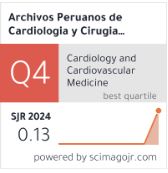Controversias en Cardiología. Parte 2. ¿Debo tratar un síndrome coronario crónico de alto riesgo invasivamente desde el inicio? No, en la mayoría de casos
DOI:
https://doi.org/10.47487/apcyccv.v1i4.98Palabras clave:
revascularización miocárdica, terapéutica, enfermedad coronariaResumen
La definición de síndrome coronario crónico de alto riesgo varía según la prueba no invasiva empleada para evidenciar isquemia, lo que se consigue a través de un aumento del trabajo miocárdico y la demanda de oxígeno, generados con el uso de fármacos o el ejercicio. El abordaje inicial nos sumerge en la discusión de contextualizar en qué casos priorizar la terapia médica óptima inicial, frente al manejo invasivo inicial con el objetivo de lograr la revascularización miocárdica. Este aspecto central será desarrollado en esta revisión, tomando en cuenta diversos estudios realizados hasta la fecha, en los que el manejo invasivo inicial no ha demostrado ser superior a la terapia médica óptima inicial en resultados clínicos relevantes como muerte o eventos adversos cardiovasculares mayores.
Descargas
Referencias
Zipes D, Libby P, Bonow R, et al. Braunwald’s Heart Disease: A Textbook of Cardiovascular Medicine. 11th. ed. Philadelphia.Elsevier.2019
Sisko AM, Keehan SP, Poisal JA, et al. National health expenditure projections, 2018–27: Economic and demographic trends drive spending and enrollment growth. Health Aff (Millwood) 2019; 38:491–501
Katz D, Gavin MC. Stable Ischemic Heart Disease. Ann Intern Med. 2019 Aug 6;171(3):ITC17-ITC32. doi: 10.7326/AITC201908060. PMID:31382288.
Magnuson EA, Farkouh ME, Fuster V, et al. Cost-effectiveness ofpercutaneous coronary intervention with drug eluting stents versus bypass surgery for patients with diabetes mellitus and multivessel coronary artery disease: results from the FREEDOM trial Circulation. 2013;127(7):820-831. Doi:10.1161/CIRCULATIONAHA.112.147488
Kones R, Rumana U. Stable Ischemic Heart Disease. Heart Fail Clin.2016;12(1):11- 29.doi:10.1016/j.hfc.2015.08.003.
Knuuti J, Wijns W, Saraste A, et al. 2019 ESC Guidelines for the diagnosis and management of chronic coronary syndromes. Eur Heart J. 2020;41(3):407-477. Doi:10.1093/eurheartj/ehz425.
Ferraro R, Latina JM, Alfaddagh A, et al. Evaluation and Management of Patients With Stable Angina: Beyond the Ischemia Paradigm: JACC State-of-the-Art Review. J Am Coll Cardiol. 2020;76(19):2252-2266. Doi:10.1016/j.jacc.2020.08.078
Boden WE, O’Rourke RA, Teo KK, et al. Optimal medical therapy with or without PCI for stable coronary disease. N Engl J Med. 2007;356(15):1503-1516. doi:10.1056/NEJMoa070829
Steg PG, Greenlaw N, Tendera M, et al. Prevalence of anginal symptoms and myocardial ischemia and their effect on clinical outcomes in outpatients with stable coronary artery disease: data from the International Observational CLARIFY Registry. JAMA Intern Med. 2014;174(10):1651-1659. Doi:10.1001/jamainternmed.2014.3773.
Fihn SD, Blankenship JC, Alexander KP, et al. 2014 ACC/AHA/AATS/ PCNA/SCAI/STS focused update of the guideline for the diagnosis and management of patients with stable ischemic heart disease: a report of the American College of Cardiology/American Heart Association Task Force on Practice Guidelines, and the American Association for Thoracic Surgery, Preventive Cardiovascular Nurses Association, Society for Cardiovascular Angiography and Interventions, and Society of Thoracic Surgeons. J Am Coll Cardiol. 2014;64(18):1929-1949. doi:10.1016/j.jacc.2014.07.017.
Baskaran L, Danad I, Gransar H, et al. A Comparison of the Updated Diamond-Forrester, CAD Consortium, and CONFIRM History-Based Risk Scores for Predicting Obstructive Coronary Artery Disease in Patients with Stable Chest Pain: The SCOT-HEART Coronary CTA Cohort. JACC Cardiovasc Imaging. 2019;12(7 Pt 2):1392-1400. Doi:10.1016/j.jcmg.2018.02.020
Winther S, Nissen L, Westra J, et al. Pre-test probability prediction in patients with a low to intermediate probability of coronary artery disease: a prospective study with a fractional flow reserve endpoint. Eur Heart J Cardiovasc Imaging. 2019;20(11):1208-1218. Doi:10.1093/ehjci/jez058
Juarez-Orozco LE, Saraste A, Capodanno D, et al. Impact of a decreasing pre-test probability on the performance of diagnostic tests for coronary artery disease. Eur Heart J Cardiovasc Imaging. 2019;20(11):1198-1207. Doi:10.1093/ehjci/jez054.
NationaL Institute for Health and Care Excellence. Chest pain of recent onset: assessment and diagnosis of recent onset chest pain or discomfort of suspected cardiac origin (update) Clinical guideline 95. London: National Institute for Health and Care Excellence; 2016.
Carrabba N, Migliorini A, Pradella S, et al. Old and New NICE Guidelines for the Evaluation of New Onset Stable Chest Pain: A Real-World Perspective [published correction appears in Biomed Res Int. 2019 Mar 7;2019:9637490].
Biomed Res Int. 2018;2018:3762305. Published 2018 Nov 8. doi:10.1155/2018/3762305.
Ohman E, Chronic Stable Angina. N Engl J Med. 2016; 374(12): 1167-76. DOI: 10.1056/NEJMcp1502240.
Douglas PS, Hoffmann U, Patel MR, et al. Outcomes of anatomical versus functional testing for coronary artery disease. N Engl J Med.2015;372(14):1291-1300. doi:10.1056/NEJMoa1415516.
Budoff MJ, Mayrhofer T, Ferencik M, et al. Prognostic Value of Coronary Artery Calcium in the PROMISE Study (Prospective Multicenter Imaging Study for Evaluation of Chest Pain). Circulation. 2017;136(21):1993-2005. doi:10.1161/CIRCULATIONAHA.117.030578.
SCOT-HEART investigators. CT coronary angiography in patients with suspected angina due to coronary heart disease (SCOTHEART): an open-label, parallel-group, multicentre trial [published correction appears in Lancet. 2015 Jun 13;385(9985):2354]. Lancet. 2015;385(9985):2383-2391. doi:10.1016/S0140-6736(15)60291-4.
Bittencourt MS, Hulten EA, Murthy VL, et al. Clinical Outcomes After Evaluation of Stable Chest Pain by Coronary Computed Tomographic Angiography Versus Usual Care: A Meta-Analysis. Circ Cardiovasc Imaging. 2016;9(4):e004419. doi:10.1161/CIRCIMAGING.115.004419.
Jørgensen ME, Andersson C, Nørgaard BL, et al. Functional Testing or Coronary Computed Tomography Angiography in Patients with Stable Coronary Artery Disease. J Am Coll Cardiol. 2017;69(14):1761-1770. doi:10.1016/j.jacc.2017.01.046.
Cheng VY, Berman DS, Rozanski A, et al. Performance of the traditional age, sex, and angina typicality-based approach for estimating pretest probability of angiographically significant coronary artery disease in patients undergoing coronary computed tomographic angiography: results from the multinational coronary CT angiography evaluation for clinical outcomes: an international multicenter registry (CONFIRM). Circulation. 2011;124(22):2423-8. doi:10.1161/CIRCULATIONAHA.111.039255.
Bittner DO, Mayrhofer T, Budoff M, et al. Prognostic Value of Coronary CTA in Stable Chest Pain: CAD-RADS, CAC, and Cardiovascular Events in PROMISE. JACC Cardiovasc Imaging. 2019;13(7):1534-1545. doi:10.1016/j.jcmg.2019.09.012.
Maron DJ, Hochman JS, Reynolds HR, et al. Initial Invasive or Conservative Strategy for Stable Coronary Disease. N Engl J Med.2020;382(15):1395-1407. doi:10.1056/NEJMoa1915922.
Boden WE, O’Rourke RA, Teo KK, et al. Optimal medical therapy with or without PCI for stable coronary disease. N Engl J Med. 2007;356(15):1503-1516. doi:10.1056/NEJMoa070829
Weintraub WS, Hartigan PM, Mancini GBJ, et al. Effect of Coronary Anatomy and Myocardial Ischemia on Long-Term Survival in Patients with Stable Ischemic Heart Disease. Circ Cardiovasc Qual Outcomes. 2019;12(2):e005079. doi:10.1161/CIRCOUTCOMES.118.005079.
Abrams J. Clinical practice: chronic stable angina. N Engl J Med 2005; 352: 2524–2533.
Bangalore S, Steg G, Deedwania P, et al. Beta-blocker use and clinical outcomes in stable outpatients with and without coronary artery disease. JAMA. 2012;308(13):1340-1349.
Ferrari R, Camici PG, Crea F, et al. Expert consensus document: A ‘diamond’ approach to personalized treatment of angina. Nat Rev Cardiol. 2018;15(2):120-132. doi:10.1038/nrcardio.2017.131.
Ferrari R, Ford I, Fox K, et al. Efficacy and safety of trimetazidine after percutaneous coronary intervention (ATPCI): a randomised, doubleblind,placebo-controlled trial. The Lancet. 2020; 396: 830-838. Doi:10.1016/S0140-6736(20)31790-6.
Eikelboom J, Connolly S, Bosch J. Rivaroxaban with or without Aspirin in Stable Cardiovascular Disease. N Engl J Med. 2017; 377(14): 1319-1330. Doi: 10.1056/NEJMoa1709118
Cannon C, Blazing M, Giugliano R, et al. Ezetimibe Added to Statin Therapy after Acute Coronary Syndromes. NEJM. 2015: 372: 2387-97.
Nissen S, Tuzcu E, Libby P, et al. Effect of Antihipertensive agents on cardiovascular events in Patients with coronary disease and Normal Blood Pressure. The CAMELOT Study: A Randomized Controlled Trial.
JAMA. 2004: 292(18): 2217-226.
Ridker PM, Everett BM, Thuren T, et al. Antiinflammatory Therapy with Canakinumab for Atherosclerotic Disease. N Engl J Med.2017;377(12):1119-1131. doi:10.1056/NEJMoa1707914.
Bhatt D, Steg G, Miller M, et al. Cardiovascular Risk Reduction with Icosapent Ethyl for Hypertriglyceridemia. N Engl J Med. 2019; 380:11-22. Doi. 10.1056/NEJMoa1812792.
Marso S, Daniels G, Brown-Frandsen K, et al. Liraglutide and Cardiovascular Outcomes in Type 2 Diabetes. N Engl J Med. 2016;375: 311-322. Doi: 10.1056/NEJMoa1603827.
Hueb WA, Bellotti G, de Oliveira SA, et al. The Medicine, Angioplasty or Surgery Study (MASS): a prospective, randomized trial of medical therapy, balloon angioplasty or bypass surgery for single proximal left anterior descending artery stenoses. J Am Coll Cardiol.1995;26(7):1600-1605. doi:10.1016/0735-1097(95)00384-3
Hueb WA, Soares PR, Almeida De Oliveira S, et al. Five-year follow-op of the medicine, angioplasty, or surgery study (MASS): A prospective, randomized trial of medical therapy, balloon angioplasty, or bypass surgery for single proximal left anterior descending coronary artery stenosis. Circulation. 1999;100(19 Suppl):II107-II113. doi:10.1161/01.cir.100.suppl_2.ii-107
Parisi AF, Folland ED, Hartigan P. A comparison of angioplasty with medical therapy in the treatment of single-vessel coronary artery disease. Veterans Affairs ACME Investigators. N Engl J Med.1992;326(1):10-16. doi:10.1056/NEJM199201023260102.
Hartigan PM, Giacomini JC, Folland ED, Parisi AF. Two- to three-year follow-up of patients with single-vessel coronary artery disease randomized to PTCA or medical therapy (results of a VA cooperative study). Veterans Affairs Cooperative Studies Program ACME Investigators. Angioplasty Compared to Medicine. Am J Cardiol. 1998;82(12):1445-1450. doi:10.1016/s0002-9149(98)00685-7.
Folland ED, Hartigan PM, Parisi AF. Percutaneous transluminal coronary angioplasty versus medical therapy for stable angina pectoris: outcomes for patients with double-vessel versus singlevessel coronary artery disease in a Veterans Affairs Cooperative randomized trial. Veterans Affairs ACME InvestigatorS. J Am Coll Cardiol. 1997;29(7):1505-1511. doi:10.1016/s0735-1097(97)00097-1.
Coronary angioplasty versus medical therapy for angina: the second Randomised Intervention Treatment of Angina (RITA-2) trial. RITA- 2 trial participants. Lancet. 1997 Aug 16;350(9076):461-8. PMID:9274581. Doi: 10.1016/S0140-6736(97)07298-X.
Henderson RA, Pocock SJ, Clayton TC, et al. Seven-year outcome in the RITA-2 trial: coronary angioplasty versus medical therapy. J Am Coll Cardiol. 2003;42(7):1161-1170. doi:10.1016/s0735-1097(03)00951-3
Hueb W, Soares PR, Gersh BJ, et al. The medicine, angioplasty, or surgery study (MASS-II): a randomized, controlled clinical trial of three therapeutic strategies for multivessel coronary artery disease: one-year results. J Am Coll Cardiol. 2004;43(10):1743-1751. doi:10.1016/j.jacc.2003.08.065
Hueb W, Lopes NH, Gersh BJ, et al. Five-year follow-up of the Medicine, Angioplasty, or Surgery Study (MASS II): a randomized controlled clinical trial of 3 therapeutic strategies for multivessel coronary artery disease. Circulation. 2007;115(9):1082-1089. doi:10.1161/CIRCULATIONAHA.106.625475.
Pitt B, Waters D, Brown WV, et al. Aggressive lipid-lowering therapy compared with angioplasty in stable coronary artery disease. Atorvastatin versus Revascularization Treatment Investigators. N Engl J Med. 1999;341(2):70-76. doi:10.1056/NEJM199907083410202.
Bech GJ, De Bruyne B, Pijls NH, et al. Fractional flow reserve to determine the appropriateness of angioplasty in moderate coronary stenosis: a randomized trial. Circulation. 2001;103(24):2928-2934. doi:10.1161/01.cir.103.24.2928.
Xaplanteris P, Fournier S, Pijls NHJ, et al. Five-Year Outcomes with PCI Guided by Fractional Flow Reserve. N Engl J Med. 2018;379(3):250-259. doi:10.1056/NEJMoa1803538.
ORBITA: Al-Lamee R, Thompson D, Dehbi HM, et al. Percutaneous coronary intervention in stable angina (ORBITA): a double-blind,randomised controlled trial [published correction appears in Síndrome coronario crónico de alto riesgo. Lancet. 2018 Jan 6;391(10115):30]. Lancet. 2018;391(10115):31-40.
doi:10.1016/S0140-6736(17)32714-9.
Miller RJH, Bonow RO, Gransar H, et al. Percutaneous or surgical revascularization is associated with survival benefit in stable coronary artery disease. Eur Heart J Cardiovasc Imaging. 2020;21(9):961-970. doi:10.1093/ehjci/jeaa083.
Azadani PN, Miller RJH, Sharir T, et al. Impact of Early Revascularization on Major Adverse Cardiovascular Events
in Relation to Automatically Quantified Ischemia [published online ahead of print, 2020 Aug 16]. JACC Cardiovasc Imaging. 2020;S1936- 878X(20)30602-1. doi:10.1016/j.jcmg.2020.05.039.
Frye R, August P, Mori M, et al. A Randomized Trial of Therapies for Type 2 Diabetes and Coronary Artery Disease (BARI 2D). N Engl J Med.2009; 360(24): 2503-15. DOI: 10.1056/NEJMoa0805796.
Bangalore S, Maron DJ, O’Brien SM, et al. Management of Coronary Disease in Patients with Advanced Kidney Disease (ISQUEMIA-CKD). N Engl J Med. 2020; 382(17): 1608-18. DOI: 10.1056/NEJMoa1915925
Pfisterer M, Buser P, Osswald S, et al. Long-Term Outcome in Elderly Patients with Chronic Angina Managed Invasively Versus by Optimized Medical Therapy (TIME). Circulation. 2004; 110(10): 1213-18. DOI:10.1161/01.CIR.0000140983.69571.
Bangalore S, Maron DJ, Stone GW, Hochman JS. Routine Revascularization Versus Initial Medical Therapy for Stable Ischemic Heart Disease: A Systematic Review and Meta-Analysis of Randomized Trials. Circulation. 2020;142(9):841-857. doi:10.1161/CIRCULATIONAHA.120.048194





















